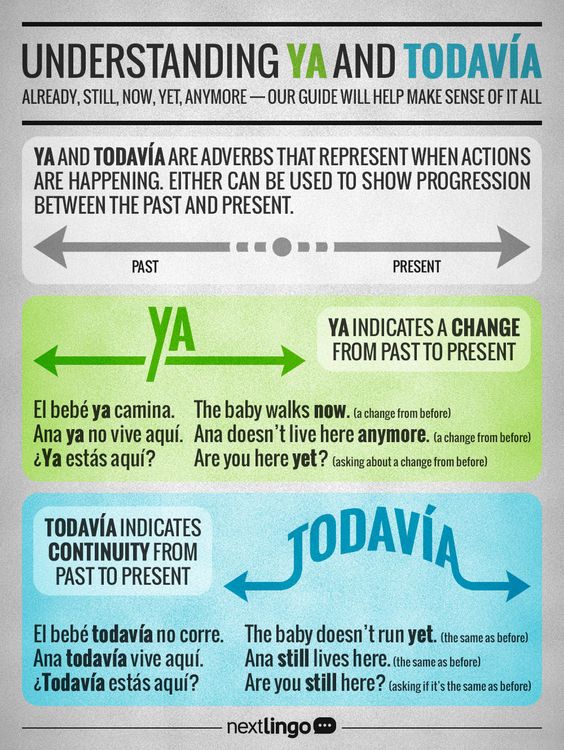The Spanish words ya ‘already’ and todavía ‘still’ are straightforward enough, but their negatives also have specific meanings: todavía no means ‘not yet’ and ya no means ‘no longer.’ So this small corner of Spanish vocabulary is actually a bit tricky.
As a Spanish student I dealt with the problem via brute force, memorizing the four expressions and their translations. This worked for years but was always a bit unsatisfying. Then, a few years ago, a member of reddit’s /r/Spanish subreddit posted the following infographic, which changed the way i think about these words. The focus on ya as change and todavía as continuity unites the positive and negative meanings of both these adverbs. I am posting it here with his permission.
(post continues after infographic)

This brings me to one of my favorite teaching anecdotes. Back in 2008, when teaching a lesson on these four adverbs, I thought that it would be fun to base an exercise on the previous year’s Republican and Democratic presidential primaries. I made a little table that showed who the candidates were at different stages at the primaries, and the students had to choose between ya and todavía to complete sentences like “En verano 2007, Hillary Clinton ________ no era candidata.” One of my students complained, “I didn’t know we had to know history for this class!” So cute…
Nice!
A note: ‘ya’ is also used (at least in Colombia) as a synonym to ‘ahora’ and ‘ahorita’. Also to say that the person will be there very soon: “Ya voy!” (then you wait another hour).
A question: and where aun/aún come in this comparison?
Thanks for this post.
Yes, I use ‘ya’ those ways, too. It’s an awesome word. I’m sorry that I have nothing to say about ‘aun’/’aún’ at this time, but will let you know if that changes!
Same in Mexico
True, I do agree.
Several years later but it might help someone out there.
Aún (with acento) is the same as todavía.
Aun (no acento) is the same as “incluso” (even).
E.g.
1 ¿Aún me quieres? = ¿Todavía me quieres? (You still love me?)
2 Te quiero aun cuando gritas = Te quiero incluso cuando gritas ( I love you even when you scream)
I think I’ve had more difficulty teaching the English expressions to Spanish-speakers, than vice versa. As an English-speaking Spanish learner, I think that once I acquired/internalized meanings for ya and todavía, the yes and no variants had there own internal, logical meaning that didn’t cause me a lot of confusion or effort to use and understand.
I’m always curious about how these things work the other way around…
Wow, you’re lucky. I remember having to really work on these. Maybe you had a better teacher…
Well, I can recall feeling some confusion about ya and todavía in their ‘positive’ sense. In fact I once asked a professor, regarding a figure from 20th century Spanish history, ‘Todavía está muerto?’ He replied, ‘Ojalá que sí. Ojalá que sí.’
¡Jajaja! This will date me, but I remember when Chevy Chase would also have a segment on “Weekend Update” confirming that “Generalísimo Francisco Franco is still dead”.
‘Ya’, this little word, is so expressive! Isn’t it also used in the colloquial sense of ‘’Enough already!’, as in ¡‘Basta ya!’ to express frustration or exasperation, sometimes even without ‘basta’?
Yes, I think so.
Thanks for sharing the neat infographic 🙂
I can add (tentatively) that I think aún can be used the same way as todavía (for continuity) but it also has another role as an intensifier: aún más, por ejemplo.
Aun (sin tilde) is used where ‘even’ in the sense of ‘in spite of / despite’ is intended – so where you could use ‘a pesar de’ (literally or in the sense of).
Thanks for the comment! I still have to look up the rules for aun versus aún from time to time. It isn’t at all intuitive for me.